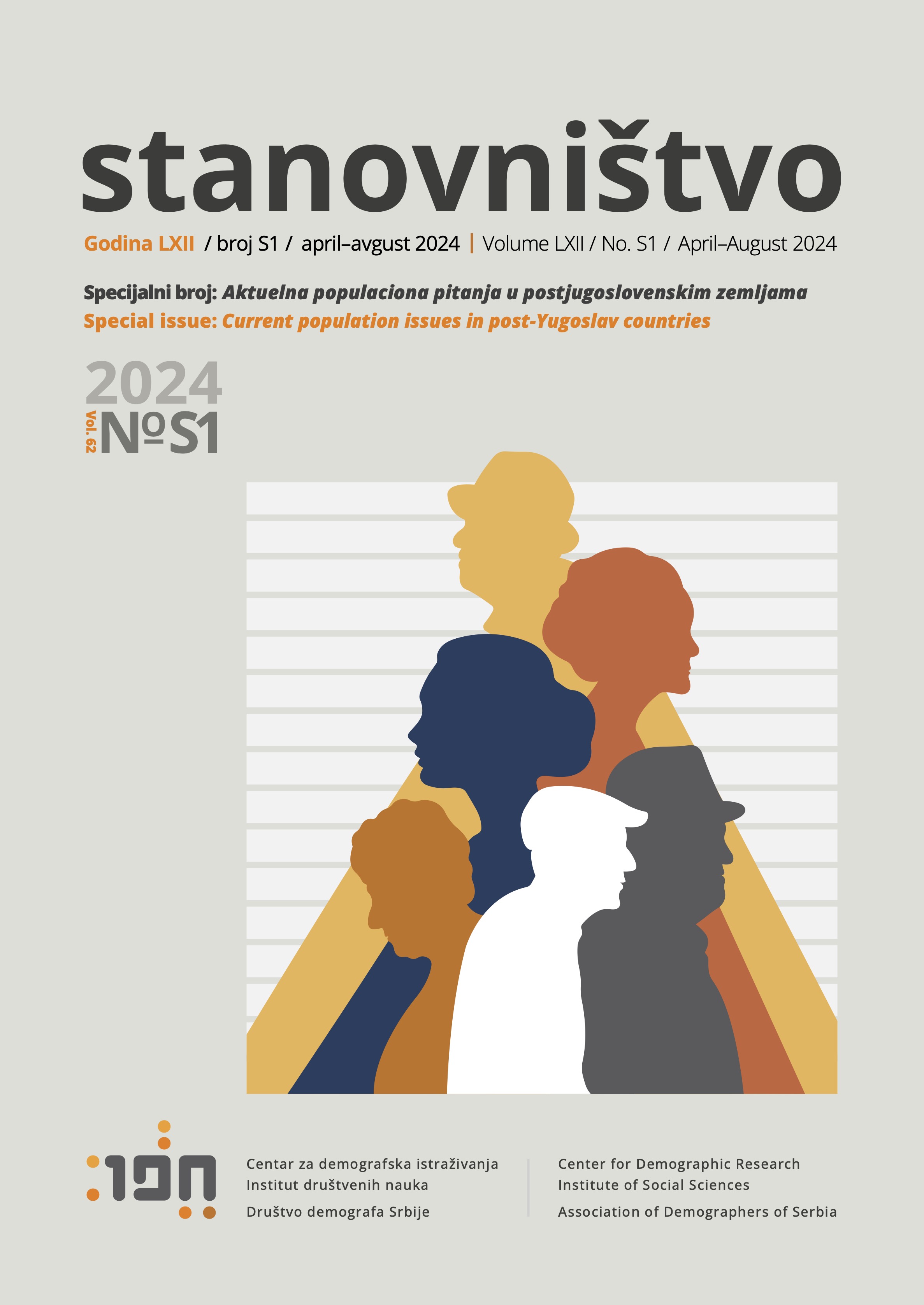Examining the link: educational expansion and non-marital fertility in Croatia
Main Article Content
Abstract
Downloads
Article Details

This work is licensed under a Creative Commons Attribution-NonCommercial 4.0 International License.
Published by the Institute of Social Sciences - Center for Demographic Research
References
Buchholz, S., Hofäcker, D., Mills, M., Blossfeld, H.-P., Kurz, K., & Hofmeister, H. (2009). Life Courses in the Globalization Process: The Development of Social Inequalities in Modern Societies. European Sociological Review, 25(1), 53–71. https://doi.org/10.1093/esr/jcn033 DOI: https://doi.org/10.1093/esr/jcn033
Cherlin, A. J. (2021). Rising nonmarital first childbearing among college-educated women: Evidence from three national studies. Proceedings of the National Academy of Sciences, 118(37), e2109016118. https://doi.org/10.1073/pnas.2109016118 DOI: https://doi.org/10.1073/pnas.2109016118
Croatian Bureau of Statistics (2023a). Population Aged 15 and Over by Educational Attainment and Sex, 1961 – 2021 Censuses. Data file. https://podaci.dzs.hr/en/statistics/population/census/
Croatian Bureau of Statistics (2023b). Population Aged 15 and over by Educational Attainment, Age and Sex, by Towns/Municipalities, 2021 Census. Data file. https://podaci.dzs.hr/en/statistics/population/census/
Eurostat (2024). Fertility indicators. Statistical database. https://ec.europa.eu/eurostat/databrowser/view/demo_find/default/table?lang=en&category=demo.demo_fer
Frejka, T. (2008). Overview Chapter 5: Determinants of family formation and childbearing during the societal transition in Central and Eastern Europe. Demographic Research, 19(7), 139–170. https://doi.org/10.4054/DemRes.2008.19.7 DOI: https://doi.org/10.4054/DemRes.2008.19.7
Hoem, J. M., Mureşan, C., & Hărăguş, M. (2013). Recent Features of Cohabitational and Marital Fertili-ty in Romania. Population, 68(4), 579–605. https://doi.org/10.3917/popu.1304.0667 DOI: https://doi.org/10.4054/MPIDR-WP-2013-007
Jalovaara, M., & Andersson, G. (2018). Disparities in Children’s Family Experiences by Mother’s Soci-oeconomic Status: The Case of Finland. Population Research and Policy Review, 37(5), 751–768. https://doi.org/10.1007/s11113-018-9485-1 DOI: https://doi.org/10.1007/s11113-018-9485-1
Kiernan, K. (2001). European perspectives on nonmarital childbearing. In L. L. Wu, & B. Wolfe B (Eds.) Out of Wedlock: Causes and Consequences of Non-marital Fertility (pp. 77–108). New York: Russell Sage Foundation. http://www.jstor.org/stable/10.7758/9781610445603.8
Kiernan, K. (2004). Unmarried Cohabitation and Parenthood in Britain and Europe, Law & Policy, 26(1), 33–55. https://doi.org/10.1111/j.0265-8240.2004.00162.x DOI: https://doi.org/10.1111/j.0265-8240.2004.00162.x
Kitagawa, E. M. (1955). Components of a difference between two rates. Journal of the American Statistical Association, 50(272): 1168–1194. https://doi.org/10.2307/2281213 DOI: https://doi.org/10.1080/01621459.1955.10501299
Klesment, M., & Van Bavel, J. (2017). The Reversal of the Gender Gap in Education, Motherhood, and Women as Main Earners in Europe. European Sociological Review, 33(3), 465–481. https://doi.org/10.1093/esr/jcw063 DOI: https://doi.org/10.1093/esr/jcw063
Konietzka, D., & Kreyenfeld, M. (2002). Women's Employment and Non-Marital Childbearing: A Com-parison between East and West Germany in the 1990s. Population, 57(2), 331–357. https://doi.org/10.3917/popu.202.0359 DOI: https://doi.org/10.3917/pope.202.0331
Lappegård, T., Klusener, S., & Vignoli, D. (2018). Why are Marriage and Family Formation Increasingly Disconnected across Europe? A Multi-level Perspective on Existing Theories. Population, Space and Place, 24(2), 1–15. https://doi.org/10.1002/psp.2088 DOI: https://doi.org/10.1002/psp.2088
Lesthaeghe, R. (1995). The second demographic transition in Western countries. In M. K. Oppen-heim, & A.-M. Jensen (Eds.), Gender and family change in industrialized countries (pp. 17 - 62). Ox-ford: Clarendon Press. DOI: https://doi.org/10.1093/oso/9780198289708.003.0002
Lesthaeghe, R. (2010). The unfolding story of the second demographic transition. Population and Development Review, 36(2), 211–251. https://doi.org/10.1111/j.1728-4457.2010.00328.x DOI: https://doi.org/10.1111/j.1728-4457.2010.00328.x
Lesthaeghe, R. (2014). The second demographic transition: A concise overview of its development. Proceedings of the National Academy of Sciences, 111(51), 18112-18115. https://doi.org/10.1073/pnas.1420441111 DOI: https://doi.org/10.1073/pnas.1420441111
Lesthaeghe, R. (2020). The second demographic transition, 1986–2020: sub-replacement fertility and rising cohabitation—a global update. Genus, 76(1). https://doi.org/10.1186/s41118-020-00077-4 DOI: https://doi.org/10.1186/s41118-020-00077-4
McLanahan, S. (2004). Diverging destinies: How children are faring under the second demographic transition. Demography, 41(4), 607–627. https://doi.org/10.1353/dem.2004.0033 DOI: https://doi.org/10.1353/dem.2004.0033
McLanahan, S., & Jacobsen, W. (2015). Diverging Destinies Revisited. In P.R. Amato, A. Booth, S. M. McHale, & J. Van Hook (Eds.), Families in an Era of Increasing Inequality (pp. 3–23). Cham: Springer International Publishing. DOI: https://doi.org/10.1007/978-3-319-08308-7_1
McLanahan, S., & Percheski, C. (2008). Family Structure and the Reproduction of Inequalities. Annual Review of Sociology, 34, 257–276. https://doi.org/10.1146/annurev.soc.34.040507.134549 DOI: https://doi.org/10.1146/annurev.soc.34.040507.134549
Mrđen, S. (1997). Rađanja izvan braka u Hrvatskoj. Geoadria, 2(1), 63–76. https://doi.org/10.15291/geoadria.244 DOI: https://doi.org/10.15291/geoadria.244
Ní Bhrolcháin, M., & Beaujouan, É. (2013). Education and Cohabitation in Britain: A Return to Tradi-tional Patterns? Population and Development Review, 39(3), 441–458. https://doi.org/10.1111/j.1728-4457.2013.00611.x DOI: https://doi.org/10.1111/j.1728-4457.2013.00611.x
Pavić, D. (2014). Trend i čimbenici izvanbračnih rođenja u Hrvatskoj od 1998. do 2012. godine. Revija za sociologiju, 44(2), 139–162. https://doi.org/10.5613/rzs.44.2.2 DOI: https://doi.org/10.5613/rzs.44.2.2
Perelli-Harris, B., & Gerber, T. P. (2011). Nonmarital Childbearing in Russia: Second Demographic Transition or Pattern of Disadvantage? Demography, 48(1), 317–342. https://doi.org/10.1007/s13524-010-0001-4 DOI: https://doi.org/10.1007/s13524-010-0001-4
Perelli-Harris, B., Sigle-Rushton, W., Kreyenfeld, M., Lappegård, T., Keizer, R., & Berghammer, C. (2010). The educational gradient of childbearing within cohabitation in Europe. Population and De-velopment Review, 36(4), 775–801. https://doi.org/10.1111/j.1728-4457.2010.00357.x DOI: https://doi.org/10.1111/j.1728-4457.2010.00357.x
Petrović, M. (2011). Changes of Marital Behaviour and Family Patterns in Post-Socialist Countries: Delayed, Incomplete or Specific Second Demographic Transition? Stanovništvo, 49(1), 53–78. https://doi.org/10.2298/STNV1101053P DOI: https://doi.org/10.2298/STNV1101053P
Preston, S. P., Heuveline, P., & Guillot, M. (2001). Demography: Measuring and Modeling Population Processes. Oxford: Blackwell Publishers.
Schnor, C., & Jalovaara, M. (2020). The increase in non-marital childbearing and its link to educational expansion. Acta Sociologica, 63(4), 400–421. https://doi.org/10.1177/0001699319877922 DOI: https://doi.org/10.1177/0001699319877922
Sobotka, T. (2008). Overview Chapter 6: The diverse faces of the Second Demographic Transition in Europe. Demographic Research, 19(8), 171–224. https://doi.org/10.4054/DemRes.2008.19.8 DOI: https://doi.org/10.4054/DemRes.2008.19.8
Sobotka, T., & Toulemon, L. (2008). Overview Chapter 4: Changing family and partnership behaviour: Common trends and persistent diversity across Europe. Demographic Research, 19(6), 85–138. https://doi.org/10.4054/DemRes.2008.19.6 DOI: https://doi.org/10.4054/DemRes.2008.19.6
Štípková, M. (2015). Ideational and Economic Causes of the Rise in Non-marital Childbearing in the Czech Republic. European Journal of Population, 31(5), 473–494. https://doi.org/10.1007/s10680-015-9350-4 DOI: https://doi.org/10.1007/s10680-015-9350-4
Van Bavel, J. (2012). The reversal of gender inequality in education, union formation and fertility in Europe. Vienna Yearbook of Population Research, 10, 127–154. http://www.jstor.org/stable/41941000 DOI: https://doi.org/10.1553/populationyearbook2012s127
Van de Kaa, D. J. (1987). Europe’s second demographic transition. Population Bulletin, 42(1), 1–59.
Van de Kaa, D. J. (2001). Postmodern Fertility Preferences: From Changing Value Orientation to New Behavior. Population and Development Review, 27, 290–331. http://www.jstor.org/stable/3115262
Vitali, A., Aassve, A., & Lappegård, T. (2015). Diffusion of childbearing within cohabitation. Demogra-phy, 52(2), 355–377. https://doi.org/10.1007/s13524-015-0380-7 DOI: https://doi.org/10.1007/s13524-015-0380-7





